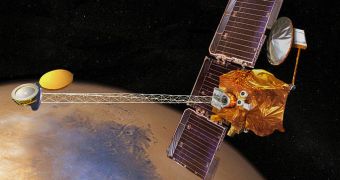NASA is proud to announce that the Mars Odyssey orbiter, which launched in 2001, is currently the new record-holder for the longest-duration mission around Mars, exceeding the record set by the agency's Mars Global Surveyor mission.
The latter functioned around the Red Planet from 1997 to 2006, but the mission eventually ended. Odyssey is now carrying on that torch, and will most likely continue to do so for a long time.
Official statistics regarding the mission show that the orbiter began the first day of its new record at 8:55 pm EST on Wednesday, December 15 (0155 GMT Thursday). This is its 3,340th day in orbit.
In addition to providing invaluable contributions for various fields of science, Odyssey plays a critical role acting as a communications relay for other missions on the surface of Mars, as they attempt to contact Earth.
The Phoenix Mars Lander, which functioned in 2008, and the Mars Exploration Rovers Spirit and Opportunity, on the planet since 2004, have had difficulties in contacting mission controllers for various reasons.
Among the most common, experts include sand storms and dust deposition, which hamper electricity production, and prevent the robots from collecting enough power to contact Earth directly.
This is where the Odyssey steps in. Its solar panels can collect a lot of sunlight, and so it takes over whatever signals come from the surface of Mars, and relays them to Earth directly.
But one of the most important thing about it is that it ensures continued science, meaning that for the past 9 years or so, it has kept an eye on ongoing Martian events, such as for example the changes the planet's carbon cycle suffers depending on the season.
Knowing such data is invaluable for understanding how Mars works, and also what happened to it in the distant past. It was through such studies that Odyssey was able to determine that frozen water exists just below the surface of the polar regions.
“The deduction that the hydrogen is in frozen water prompted NASA's Phoenix Mars Lander mission, which confirmed the theory in 2008,” say experts at the NASA Jet Propulsion Laboratory (JPL), who manage the mission.
“The Mars program clearly demonstrates that world-class science coupled with sound and creative engineering equals success and longevity,” explains the director of the Mars Exploration Program at NASA Headquarters in Washington DC, Doug McCuistion.
In the future, the orbiter is destined to support the Mars Science Laboratory (MSL) in 2012, and to ensure that permanent contact is kept with the nuclear-powered rover.

 14 DAY TRIAL //
14 DAY TRIAL //